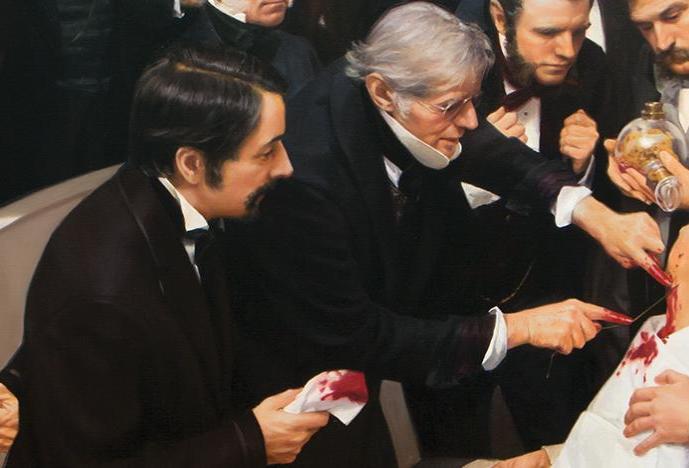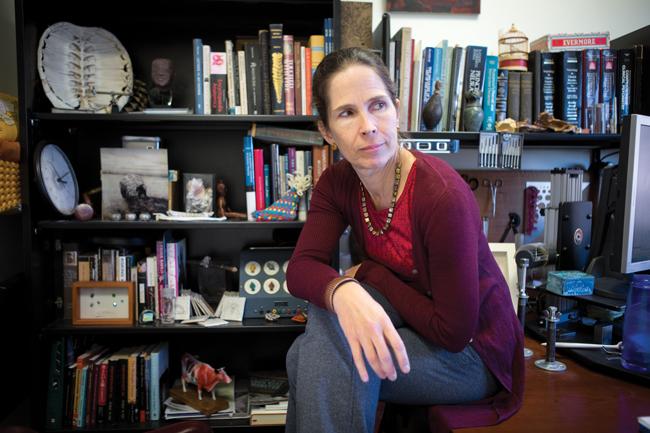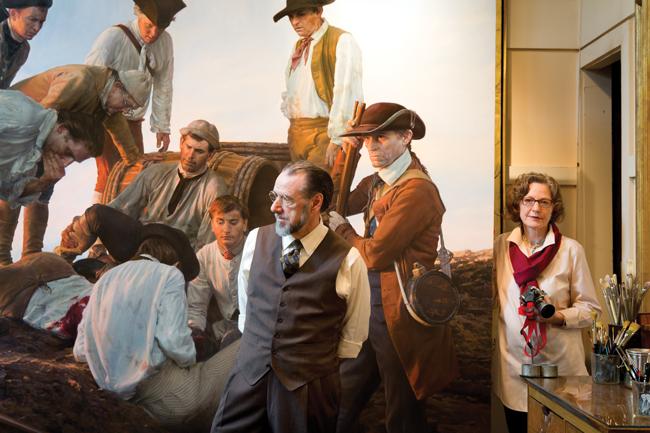
In Carolus-Duran’s The Convalescent, a bearded man leans back, exhausted, into a pillow. Carolus-Duran, the name used by nineteenth-century French artist Charles Auguste Émile Durand, brings the viewer into the sickroom, rendering the emotions of illness through light, feature, and posture.
Studying this and other such paintings and recognizing elements of her own clinical experience in them has enriched Alice Flaherty’s appreciation of sickrooms and deathbeds. It is an appreciation that translates to the clinic.
“I was rounding on a woman who was dying of breast cancer,” says Flaherty ’90, an HMS associate professor of neurology at Massachusetts General Hospital. “I felt this empathic pain, so I asked her about her suffering. She calmly said she felt at peace, that she had been contemplating the quiet, lovely light in the room.”
“I realized that some of my empathy had been the projection of my own distress,” Flaherty continues. “Her description of the calm, empty, white spaces of her sickroom gave me the aesthetic distance that allowed me to see more of what was going on with her than I had seen when my eyes were screwed tight with imagined pain.”

Whether it’s a sickroom tableau, a portrayal of a surgery, or a portrait of a clinician or researcher, depictions of medicine in art have wide-ranging effects on those who view them. In addition to revealing the beauty in everyday clinical care, art inspired by medicine can connect doctors with the history of their profession, encourage them to confront ambiguities or consider alternative points of view, help situate their experiences within a larger context, soothe or sharpen emotions, and lead them to improve patient care in unexpected ways.
Artists, subjects, and viewers connect on another level when the process for reconstructing a historical event in medicine or capturing the character of a portrait subject entails the same meticulous collection of data and keen observational skills practiced in medicine. That physicians and painters should find one another kindred spirits is not surprising given the intertwined histories and philosophies of naturalist art, science, and medicine.
Nature Studies
Ask Massachusetts-based artists Warren and Lucia Prosperi whether they feel an affinity with physicians and scientists, and they will elaborate on how they share a fascination with the nature of the human experience. To capture this fascination in their paintings, they allow themselves to be endlessly curious about the subject, struggle to balance involvement with detachment, and pursue their desire to craft scientifically accurate images based on close observation.
“We’re empiricists,” says Warren, a painter who, in collaboration with his wife, a photographer, has produced dozens of paintings for HMS-affiliated institutions. Most notable, perhaps, is their Ether Day, a work completed in 2001 and displayed in a surgical amphitheater, dubbed the Ether Dome, in the Bulfinch Building at Mass General. In that room in 1846, the use of inhaled ether as a surgical anesthetic was first demonstrated successfully.
The Prosperis adhere to the principles of naturalism, a movement that arose in Europe in the mid-nineteenth century as writers, visual artists, and filmmakers, inspired by advances in natural science, sought to apply scientific methods to their work. Reacting against the idealism and symbolism of romanticism, naturalist painters presented realistic depictions of everyday life with as little distortion as possible. An example of this style, and one that is among the more pervasive images of the caring physician in art, is the late-nineteenth century painting The Doctor by British artist Sir Samuel Luke Fildes. In the work, Fildes portrays a pensive clinician keeping watch over an ailing girl while her parents look on helplessly.
Naturalist artists gather vast amounts of data to ensure accuracy, and the Prosperis are no exception. They spend hours talking with and photographing portrait subjects until they’re satisfied that they’ve captured not only minute physical details but also the person’s essential character. For posthumous portraits and historical scenes, they conduct exhaustive archival research, consult experts on the period, and interview anyone who might have known the person or experienced an event firsthand.

“They sucked my bone marrow for details,” says Donald Barnett, a former HMS assistant clinical professor of medicine and now curator of the Joslin Diabetes Center Historical Commission. Barnett has advised the Prosperis on seven paintings depicting landmarks in Joslin’s history.
As a clinician, Barnett appreciates thorough information gathering. “Historical records tell the ‘what,’ not the ‘how,’” he says. “We brought in the details to turn a painting into a story, and we had a fanaticism for telling the story correctly.”
Details, Details
Demonstrating the effective use of ether during surgery launched U.S. medicine into the international spotlight. Little wonder that when planning to commemorate the 150th anniversary of that landmark event, the hospital’s service chiefs and physicians commissioned the Prosperis to paint a historically accurate version of what happened that day. The research the Prosperis undertook for Ether Day illustrates their dedication to telling stories correctly.
Although written documents and photographs yielded plenty of facts, crucial questions remained: Was surgeon John Collins Warren right- or left-handed? What was the nature of the incision he made? To what extent would red blood cells have oxidized and begun to separate from plasma in the basin used to capture the blood that flowed from the incision? Where would Warren and dentist William T. G. Morton, who administered the ether, have stood relative to the patient?
Over time, a detailed picture took shape. Whenever the Prosperis reached the limits of evidence, they and their consultants made logical deductions. Daguerreotypes in Harvard’s Fogg Museum, for example, show Warren holding his glasses in a manner that suggests he was right-handed. If true, that would mean he should be positioned to the patient’s right in the painting. The fact that blood would flow from the incision—this was a time before cauterization was used—meant someone would probably be there to sop it up, so given Warren’s position, the Prosperis put that person on the patient’s left along with a basin on a table. The possibility that ether wouldn’t work would have meant that the surgical team not only used restraints at the patient’s elbows and ankles but also assigned someone to hold the patient’s head still, likely from behind to remain out of Warren’s way. Thus, each decision about how to compose the scene helped another fall into place.
Reconstructing events feels like time travel, the Prosperis say, and that sense of witnessing the past with nearly photographic precision gets shared with the viewers.
“I remember being alone in the Ether Dome, feeling the history of that moment, and thinking that we had to do honor to what came before,” says Lucia. “It was a heavy responsibility.”
Adds Warren, “It was also great fun.”
Shades of Meaning
Beyond authenticity, the choices made in paintings of medical topics take on symbolic value and convey what it means to be a doctor, a patient, or part of an institution.
The doctor’s worried expression in Fildes’ iconic painting reminds practitioners that sometimes medicine reaches its limit and all it can offer is empathy with the human experience. When English artist John Collier turns the physician away from the viewer in his 1908 painting Sentence of Death, he is subtly directing the viewer’s gaze to the young male patient and his shocked expression, emphasizing how personally devastating the receipt of a terminal diagnosis can be. In Science and Charity, executed by the Spanish painter Pablo Picasso when he was 15 years old, the artist presents the doctor as the scientific observer of symptoms, focusing on his timepiece as he takes his patient’s pulse while a nurse provides compassionate care.

Paintings can also capture the moment a clinical procedure was first put into practice, such as the 1816 introduction of the stethoscope depicted in Ernest Board’s sunlit Laënnec Listening to the Chest of a Patient. In Board’s 1908 work, the early monaural cylinder itself and inventor René Laënnec take center stage. Although such paintings can boost present-day doctors’ and researchers’ confidence that their contributions could likewise change the course of medical history, artistic works can also be used to warn that not all new ideas pan out. For better or worse, French physician Simon Bernheim immortalized his hypothesis for curing tuberculosis using interspecies blood transfusions by hiring French naturalist artist Jules Adler to advertise his idea, which Adler did in The Transfusion of a Goat’s Blood.
When Barnett led the team choosing the subjects for the Joslin paintings, he tried to select caregivers and researchers who represented progress in diabetes research and treatment and to tell stories that embodied the Joslin’s values. One of the physicians selected was Priscilla White, a founding member of Joslin Clinic. White, who collected data from pregnant women for half a century, helped raise the survival rate of babies born to diabetic mothers from 56 percent to over 90 percent.
Another painting depicts a twentieth-century health care team conferring around the bed of a woman with diabetes and a foot infection. Although some people recoil from the “blood and guts” nature of the gangrenous limb, Barnett says, he believes it’s important to portray real patients who lose their legs to the disease. “Looking at the painting reminds doctors of the importance of taking care of the whole person,” he says.
Viewers’ reactions can be emotional as well as intellectual. For Barnett, standing in the Joslin lobby surrounded by the Prosperis’ paintings brings back fifty years of memories of caring for patients with juvenile diabetes.
“Tears would come to my eyes to see kids in their twenties going blind,” he says. “This art can make people aware of what it was like to be a patient or a doctor in those days, when diabetes was a war.”
Face Values
The walls of Flaherty’s office are papered with taped-up printouts of artwork by and about doctors and patients. Art books and sculptures crowd all available horizontal surfaces. Flaherty believes that repeated exposure to artistic renderings of bodies and illness can make them less threatening in reality, help health care practitioners process difficult clinical experiences, and reassure practitioners that their work fits into an older, larger context.
Nonetheless, she worries about putting too thick an aesthetic gloss on medicine.
“It makes our patients more interesting and less painful for us when we aestheticize their experience, but that also can over-anesthetize our ability to feel their pain,” she says.
Art, cautions Flaherty, can encourage doctors to ignore the messiness in real patients’ stories or to infer emotions that may not reflect patients’ actual experiences and feelings. It can, she adds, perpetuate an approach of treating patients like objects to be contemplated rather than as active participants in their own care.
At the same time, Flaherty is among those who believe that art serves doctors well when it “takes something that we encounter every day, and thought we knew, and makes us see that it is unique.”
Having witnessed physicians refer to a terrified-looking patient as “resting comfortably,” Flaherty thinks that art can teach doctors to pay attention.
“Doctors often see the jaundiced sclera but not the sad expression,” she says, “because it saves time if we ignore the pain. Looking closely at portraits can help us remember how to look at people.”
Flaherty says that close attention to facial expression helps her tell the impassivity of depression from that of Parkinson’s disease, Botox treatments, or simply personal demeanor. Occasional attempts to draw—Flaherty has taken some lessons from Warren Prosperi—have engaged her with patients’ affect even more. She has learned, for instance, that if an eyelid’s position changes by even a hundred microns, a face can be transformed from sadness to fear.
“I was talking to a patient once and said, ‘Oh, the light’s in your face,’ ” Flaherty remembers. “He said, ‘That’s so thoughtful of you.’ Don’t thank me, I thought, thank an artist.”
Stephanie Dutchen is a science writer in the HMS Office of Communications and External Relations.
Images: John Soares